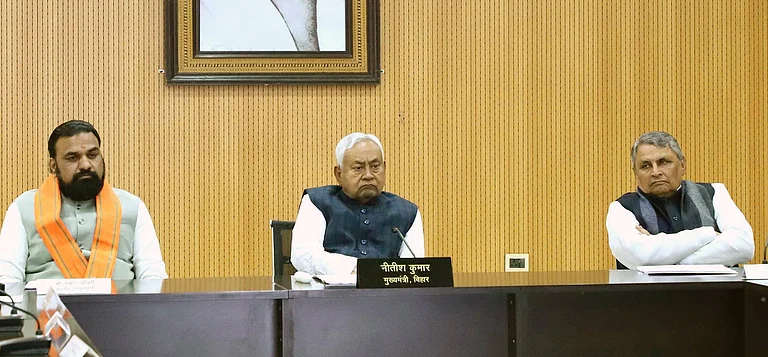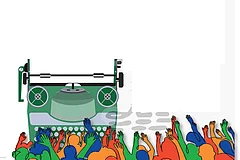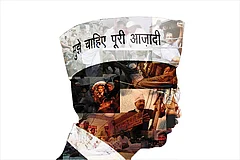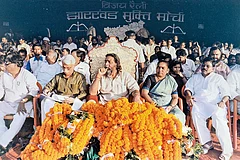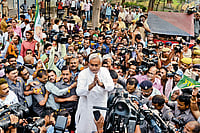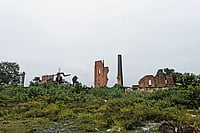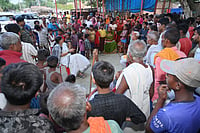On 12 February 1994, streets of Patna were jam packed with people from the countryside. They all belonged to the Kurmi caste and were heading to the Kurmi Chetna Maha Rally at the historic Gandhi Maidan. This was perhaps the first such massive mobilisation of the Kurmi caste, which is just 4 per cent of Bihar’s population.
In a government bungalow in Chhajju Bagh, just 1.5 km away from Gandhi Maidan, sat Nitish Kumar, who belongs to the same caste. He was in a doubtful state of mind due to his marginalised political status in the Janata Dal. Nitish’s man Lalan Singh alias Rajiv Ranjan Singh had been badly humiliated two years ago when he, along with other leaders, went to meet Lalu Prasad Yadav at Bihar Bhawan in New Delhi. Sankarshan Thakur noted in his book Bandhu Bihari, “This incident had infuriated Nitish Kumar. He left Bihar Bhawan murmuring, ‘Ab saath chal pana mushkil hai (now it is difficult to stay together).’”
The 12 February rally turned out to be a boon for Nitish. The rally was against the Lalu Yadav government and Nitish Kumar’s participation in it meant a rebellion against his own party as both were leaders of the Janata Dal. It was also unethical for Nitish Kumar to be a leader of a particular caste. So he was unsure about going to the rally. But after many of his colleagues insisted he attend it, Nitish finally headed there. On stage, he declared loud and clear: “Bheekh nahi hissedari chahiye (we need a share, not alms). A government which ignores our interests cannot remain in power.”
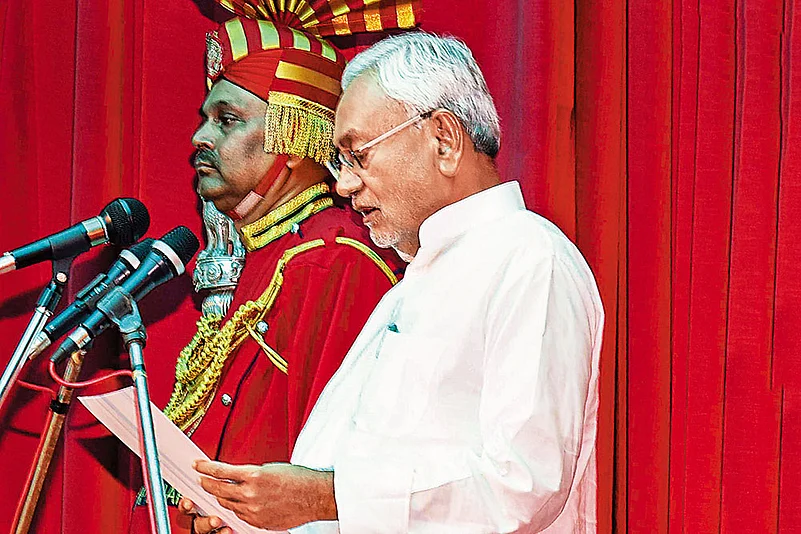
Satish Kumar, the then CPI MLA and organiser of the rally says, “Dozens of leaders and MLAs from the Kurmi caste were invited to that rally and Nitish Kumar was one of them…First, two Janata Dal MLAs addressed the crowd, but they spoke in favour of the Lalu Yadav government. The crowd threw shoes and slippers at the stage. Nitish Kumar too started speaking in favour of the Lalu Yadav government. The crowd got angry again. Nitish also had to face hooting...I said from the stage: Nitish ji bhi kurmini ke pet se hi paida hue hain, wo hamare bhai hain (Nitish Kumar was born from the womb of a Kurmi lady, he is our brother). The crowd calmed down. Sensing the urgency of the situation and the mood of the crowd, Nitish Kumar made a statement against the Lalu Yadav government.”
Within just two months of attending the rally, on April 21, Nitish Kumar along with 14 MPs of the Janata Dal formed a separate faction within the Janata Dal. And within six months he floated a new political outfit called the Samata Party. Satish Kumar also joined this party.
Alliance with the Left and the Right
In 1995, the Samata Party for the first time fought state assembly elections but experienced a humiliating defeat. In that election, out of 324 seats, the Samata Party fielded candidates on 310 seats and formed an electoral alliance with the extreme left CPI-ML. Nitish Kumar was overwhelmed with the success of the Kurmi Chetna Rally and thought that it would shake the foundations of Lalu Yadav’s government, but Yadav won 164 seats in that election while the Samata Party only bagged seven seats. This defeat was a big blow for Nitish. His alliance with the extreme left had failed. Now it was time to go with the extreme right.
Nitish Kumar had been maintaining the image of a socialist and secular leader. But when the Bharatiya Janata Party (BJP) proposed a political alliance in mid-1995, he agreed. Over the next few months, a formal announcement of the alliance was made, without any opposition from Samata leaders.
“Our aim was to remove Lalu Prasad Yadav from power, hence no one raised a voice against this alliance,” says Shivanand Tiwari, a former colleague of Nitish Kumar’s, who is currently with the Rashtriya Janata Dal (RJD).

The 1999 Lok Sabha election was a year of another split in the Janata Dal. The BJP-led NDA had won this election and the victory divided the Janata Dal into two based on the issue of forming an alliance with the BJP. The faction led by H D Deve Gowda was against it and as a result, Gowda separated from the Janata Dal and formed his own new party Janata Dal (Secular). The remaining faction led by J H Patel and Sharad Yadav changed the name of the Janata Dal to Janata Dal (United).
But as his alliance with the BJP grew, Nitish Kumar started compromising on his core ideology. In 2000, Samata Party leader Prem Kumar Mani wrote a scathing letter to Nitish Kumar, alleging his deviation from social justice. “Is it not the result of this influence that you (Nitish) have started using the word samajik samrasta (social harmony) instead of samajik nyay (social justice)? Have you ever noticed that the word ‘social harmony’, as innocent as it may sound, is very dangerous in its meaning,” he said.
2002 Gujarat Riots and Nitish Kumar’s Dilemma
The Samata Party and the BJP were two opposite poles in terms of ideology, but despite this, except for the intervening five years (when the JDU flip-flopped between NDA and RJD-led mahagathbandhan or grand alliance), both the parties remained in alliance and ran the government in Bihar and also remained partners at the Centre. Despite calling himself secular, Nitish Kumar had no problem with the BJP, not even when serious questions were raised on the role of then Chief Minister Narendra Modi in the 2002 Gujarat riots. Rather, he praised Modi and asked the people of Gujarat to forget the 2002 riots. “What happened (in 2002) was a blot. But it is not good if we remember just that and forget the other things that are happening. I congratulate Narendra bhai. Gujarat’s development is helpful for India and if Gujarat develops, the nation will also develop,” Nitish Kumar said in December 2003 while inaugurating a railway project in Kutch, Gujarat as rail minister.
In 2003, Sharad Yadav’s Janata Dal (United) merged with the Samata Party and was named Janata Dal (United). It adopted ‘arrow’ as the party symbol.
Earlier, the Samata Party’s symbol was ‘flambeau’ but later it adopted the ‘arrow’. JDU spokesperson Niraj Kumar says, “When the Samata Party merged with the Janata Dal (United), we had two symbols—the Samata Party’s flambeau and JDU’s arrow, we chose arrow. Arrow looks attractive so we opted for it as our symbol.”
“Nitish Kumar is the only face of the party. There has been a generational shift in regional parties, but the JDU lacks young leaders to carry forward the legacy.”
NDA Threw Lalu Yadav Out of Power
In the October 2005 Bihar elections, the JDU and the BJP alliance came to power in Bihar and Nitish Kumar became the chief minister. Extremely Backward Class (EBCs) and non-Yadav OBCs (other backward class) played a crucial role in this victory. In fact, these classes (except non-Yadav OBCs) also played a big role in Lalu Yadav’s win, but they did not get any benefit from the Lalu Yadav government. The JDU leadership understood this, and hence, it gave a record 48 seats to EBC leaders in the October 2005 elections.
Shivanand Tiwari says, “Lalu Prasad Yadav openly praised Muslims and Yadavs for his victory. EBCs felt that they were not getting any share in power, hence they supported Nitish Kumar and voted for NDA.”
With this victory, Nitish started strengthening EBCs. He made a provision of 20 per cent reservation for EBCs in Zilla Parishads, Panchayat Samitis and Gram Panchayats. He made a separate group and named it Mahadalit which means poorest class among Dalits. He formed the Mahadalit Commission for economic and social development of Mahadalits.
Even while being with the BJP, the JDU ensured that there were no big incidents of communal violence in Bihar, which is why since 2005, apart from sporadic communal incidents, no major clashes have taken place. However, in recent times, there have been growing incidents of communal tension in many districts during religious events, which is worrying.
Many Flip-flops
Till the year 2009, all was well between the JDU and the BJP. In a dramatic move in 2010, Nitish Kumar cancelled a dinner event for senior BJP leaders in Patna. The reason for the cancellation was an advertisement which appeared in the newspapers. In it, Narendra Modi (the then Gujarat chief minister) was thanked for the help given during the Bihar floods.
Shivanand Tiwari recalls, “After that incident, we told Nitish Kumar that he should walk out of the NDA alliance now and contest the elections alone. If Nitish Kumar had done so, he would have got public support in Bihar, but he neither paid any attention nor reacted to my words.”
Even after this incident, the JDU remained with NDA. But, in 2013, Nitish Kumar was unhappy when the BJP made Narendra Modi the prime ministerial candidate. He broke off the alliance with the saffron party and joined the RJD-led mahagathbandhan. Later he rejoined NDA in 2017, but again broke off the alliance and joined the mahagathbandhan.
The party split twice between 2014 and 2018 when Jitan Ram Manjhi and Sharad Yadav deserted the JDU and formed new parties.
In 2023, while he was with the mahagathbandhan, he had said that it was acceptable to die, but not acceptable to join the BJP again, but in January 2024, he deserted the mahagathbandhan and joined NDA.
The frequent flip-flops of the JDU plunged his supporters into a dilemma. Ranjit Mahato, a dedicated JDU voter from Nalanda district, says, “When Nitish Kumar emerged in the political arena, he was the only Kurmi leader of that stature. I am also a Kurmi, so I almost became Nitish Kumar’s fan and I admire him. But his frequent change of alliance hurts supporters like us. When the JDU goes with the BJP, Yadavs poke me and when it forms an alliance with the RJD, upper-caste people tease me. We would like the JDU to not go into any alliance.”
The two-and-a-half-decades old JDU is currently sharing power with NDA, but its future looks bleak since in all these years no second-line leaders were groomed to take the legacy forward.
MORE FROM THIS ISSUE
“Nitish Kumar is the only face of the party. There has been a generational shift in regional parties, but the JDU has no young leaders to carry forward the legacy. So, once Nitish Kumar retires from politics, which is going to happen soon, the party will face multiple splits. One faction will go with the RJD, and another faction will join the BJP. The remaining leaders will head the JDU, albeit it will remain a minor player,” political analyst Mahendra Suman says.
(This appeared in the print as 'Hop, Skip, Slip')








